Illustrated Review: How the Penguins busted the Senators' neutral zone trap

In the early stages of the Eastern Conference Final, the narrative attached to the Ottawa Senators was they were a boring team to watch, running a neutral zone trap, squeezing the offensive life out of their opponents and games.
It became such a self-aware story that fans chanted "1-3-1" at Canadian Tire Centre after the Senators drubbed the Pittsburgh Penguins 5-1 in Game 3 of the series to take a 2-1 lead. The Senators' official Twitter account made light of the description.
Whether you were in the camp the Senators' style was unwatchable, a product that would undersell a Stanley Cup Final, or on the other side of the table, after that blowout in Canada's capital, Ottawa held a series lead and had held the Penguins to three goals through three games; by the optics, the trap was trapping.
Illustrated Review: Examining Sidney Crosby's adeptness at creating space
But between Games 3 and 4, Penguins head coach Mike Sullivan made the necessary adjustments and convincing offensive performances in Games 4 and 5 have the Penguins in control of the series and a victory away from reaching consecutive Stanley Cup Finals.
Through nine periods and part of an overtime to begin the series, Ottawa had very much held the Penguins in check. Besides the three goals-for, the Penguins were also producing fewer scoring chances and high-danger scoring chances than they did over the first two rounds against the Columbus Blue Jackets and Washington Capitals.
With the Senators clogging the neutral zone and attempting to force the Penguins to dump the puck in, Pittsburgh was struggling to generate scoring chances and high-danger scoring chances in the first three games of the series.
The Penguins were actually taking more total attempts, but that was a factor of having a greater share of puck possession. Ottawa, knowing it was punching up in a higher weight class, was taking a lot of jabs and body shots but protecting against the big knockout blow.
But like any good fighter, the Penguins, behind on the scorecard entering the fourth round, went back into their corner, received from tactical changes from their coach and came out swinging.
On Sunday, when the Penguins blitzed the Senators for seven goals to take their first series lead, all five even-strength goals Pittsburgh scored came off sequences that the Senators had possession of the puck in their defensive zone.
Instead of trying to circumvent what Ottawa was doing in the neutral zone, the Penguins took a different approach, throwing jabs from distance to put the Senators in a comfortable defensive posture and then closing the space furiously on the forecheck, throwing heavy punches in tonight creating possession and negating the desired affects of the trap.
Desperate Ottawa tries to avoid elimination by Penguins
"When we have to put the puck in forecheck, we're getting on pucks quickly," Sullivan said following Game 5. "We're forcing them to have to make plays under pressure. Usually that results in an errant pass or a loose puck. Then we can create some offense that way."
There are a few things to unpack there. First is Sullivan's admission that they have to be a forechecking team. Early in the series, Pittsburgh was struggling to put itself in good spots on the forecheck, playing right into Ottawa's hands.
With Pittsburgh trying to break the puck out, Kyle Turris applies high pressure on Evgeni Malkin. Whether this is considered a '1-3-1' or a '1-4' isn't really important; Turris's job in this sequence is to funnel the puck to one side, which he does.
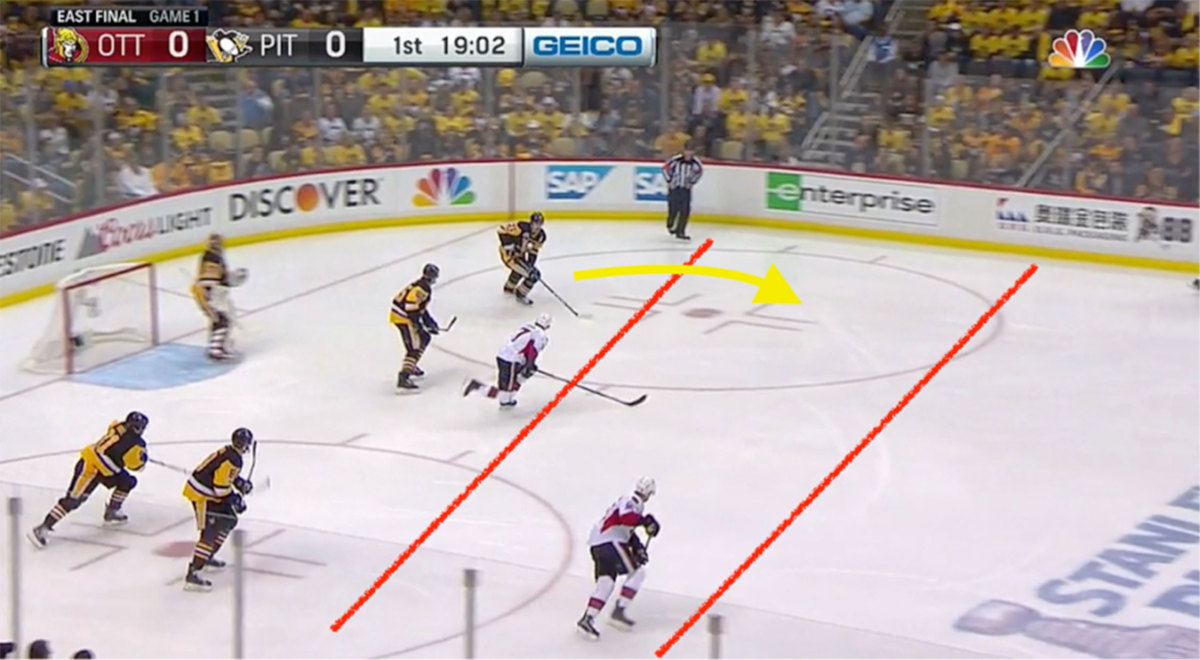
Malkin is faced with a decision now: play the puck directly ahead toward Chris Kunitz or dump it deep. The problem though is Ottawa is set up to defend this: Dion Phaneuf, not in the frame, is positioned on the weak-side, a kick returner waiting for Pittsburgh to punt the puck.
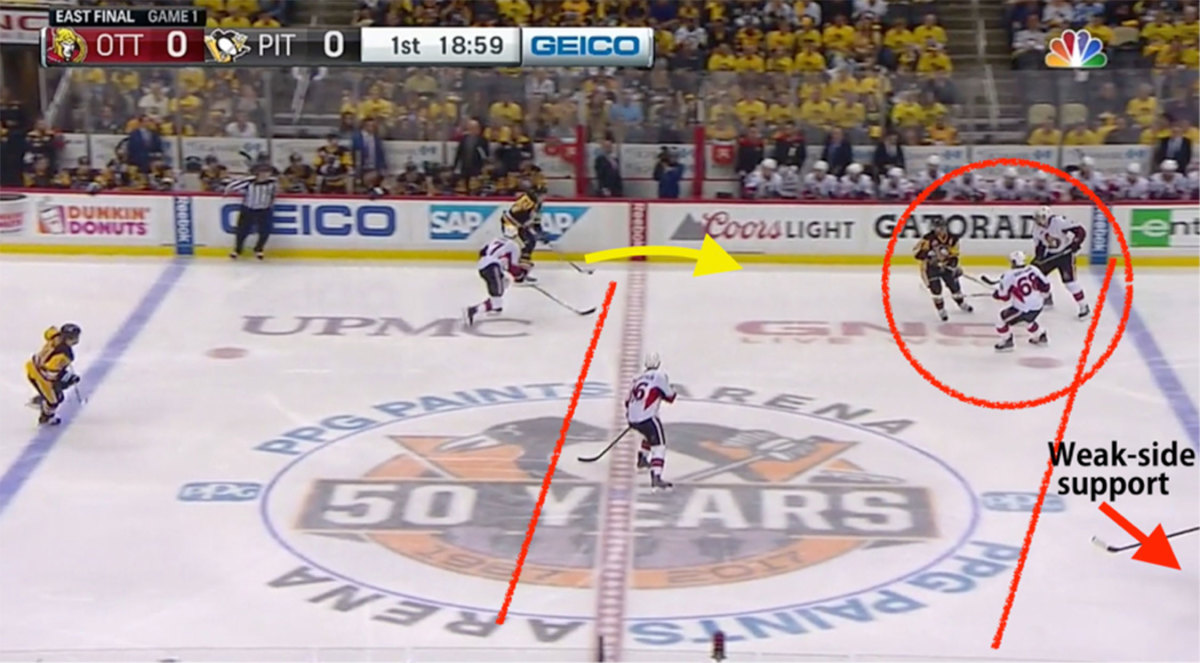
And not only does Malkin play a cross-corner dump, not forcing Phaneuf to cross over to retrieve the puck, but it's Malkin who is the first in on the forecheck. Phaneuf has plenty of time to gain control, pick his head up, and reverse the play to Erik Karlsson who facilitates a quick out.
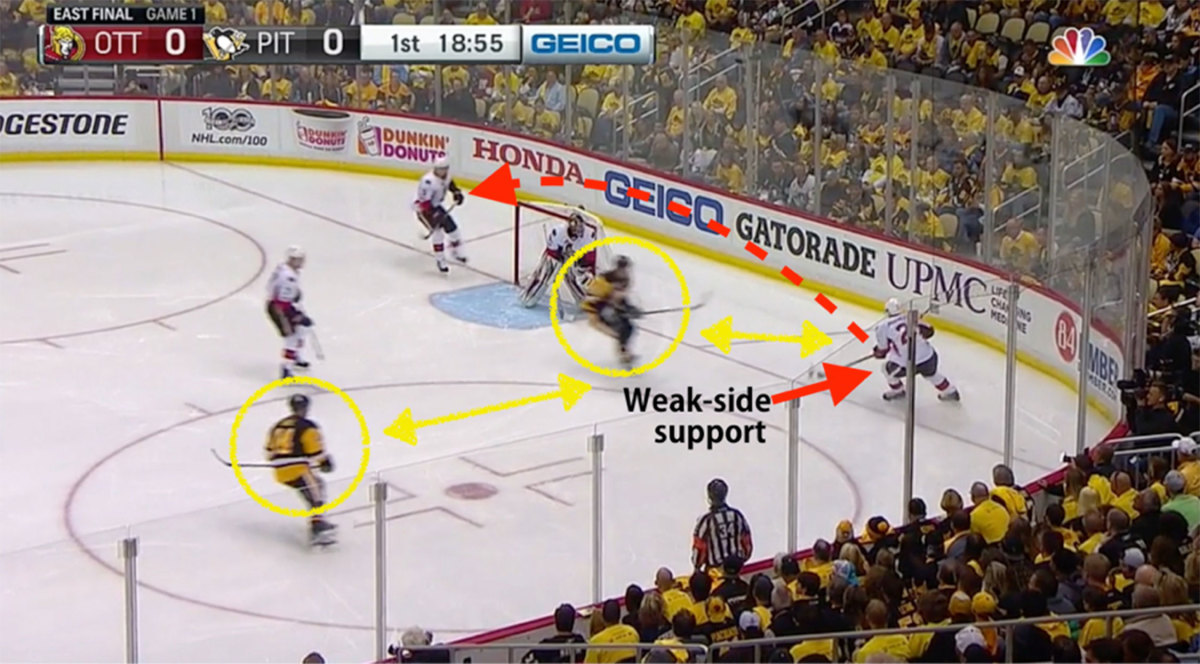
This plays out almost identically for the Penguins. Turris is again the forward up top, with the Senators conceding a lot of space between him and the next level.
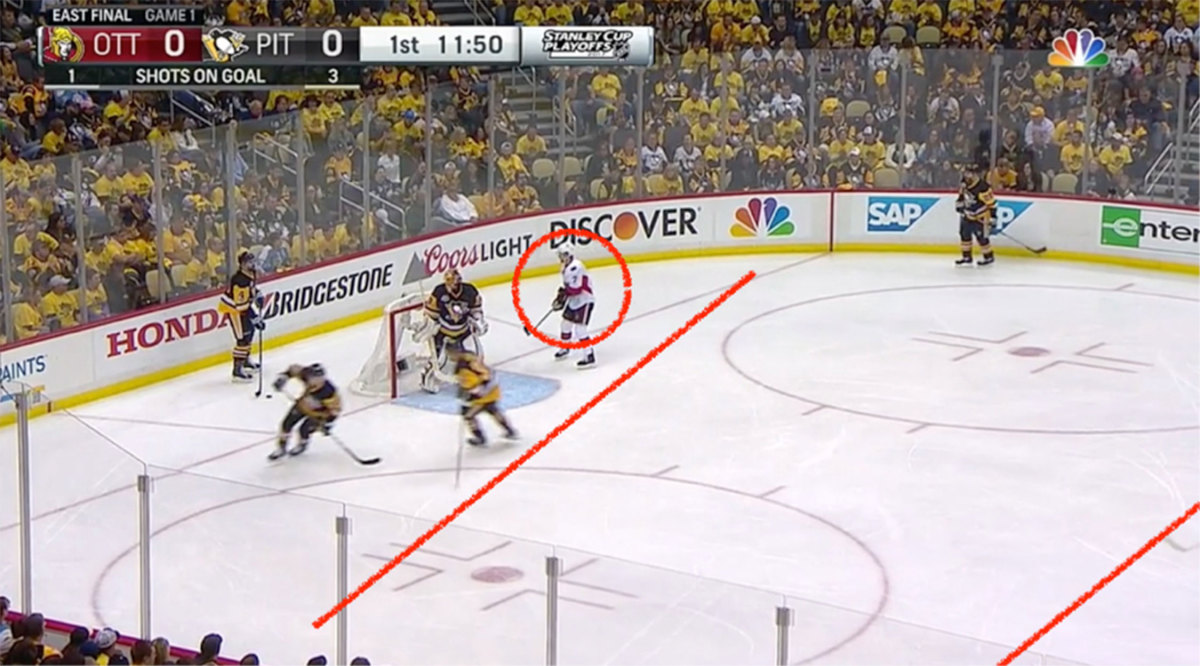
Justin Schultz plays the puck up to Ian Cole, and again, Ottawa is allowing the play to develop up the left side of the ice. As soon as Cole gains the red line, he's again met with pressure and a decision: dump the puck in (Marc Methot is that last line of defense) or attack the teeth of the trap.
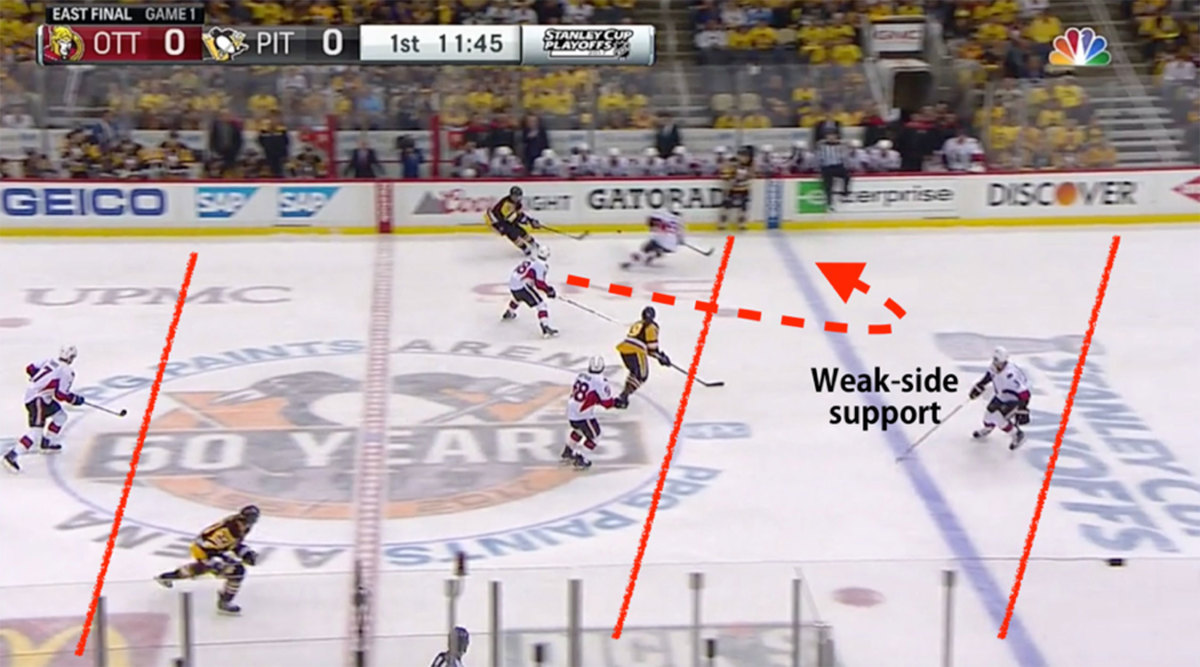
And after Cole tries to force a pass to Scott Wilson, Ryan Dzingel slides over, intercepts the puck and easily clears up the boards. Pittsburgh went from having all the time and space to make a play out of their own end to a 1-on-4 at the offensive blue line.
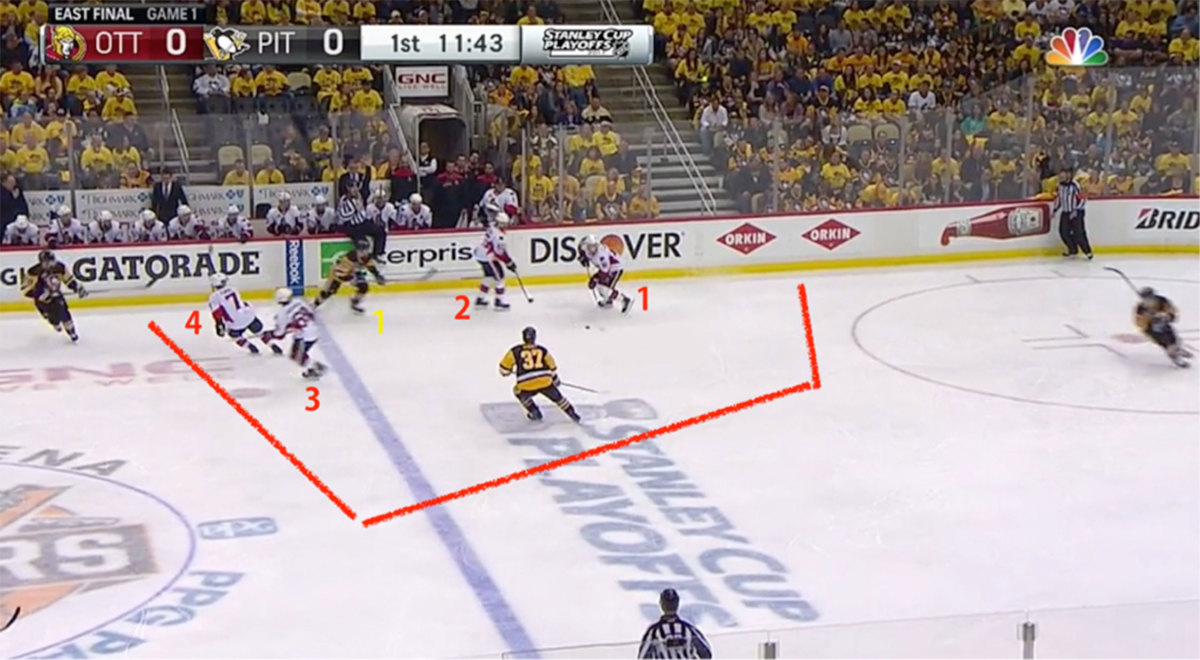
The challenge for Pittsburgh became not how to change the layout in the neutral zone, but how to be better puck-hunters once the play was in Ottawa's end.
And in Game 4, Pittsburgh changed its stance and started landing effective punches on the forecheck. By putting pucks in more vulnerable areas and positioning forwards near the blue line in easier spots to retrieve said pucks, Pittsburgh started applying more pressure on the Ottawa skaters going back on their own icing line
Right before Brian Doumolin scored to make it 3-0, Pittsburgh won a neutral-zone faceoff, sent the puck down the boards and forced Ottawa into a turnover.
Though this isn't a puck Pittsburgh carried out from its own end, Ottawa is still in its familiar shape. Phaneuf, not in the frame, is closer to the icing line. Doumolin sends the puck cross-corner, and Phil Kessel and Wilson are tight on the blue line, in good positions to quickly get in on the forecheck.
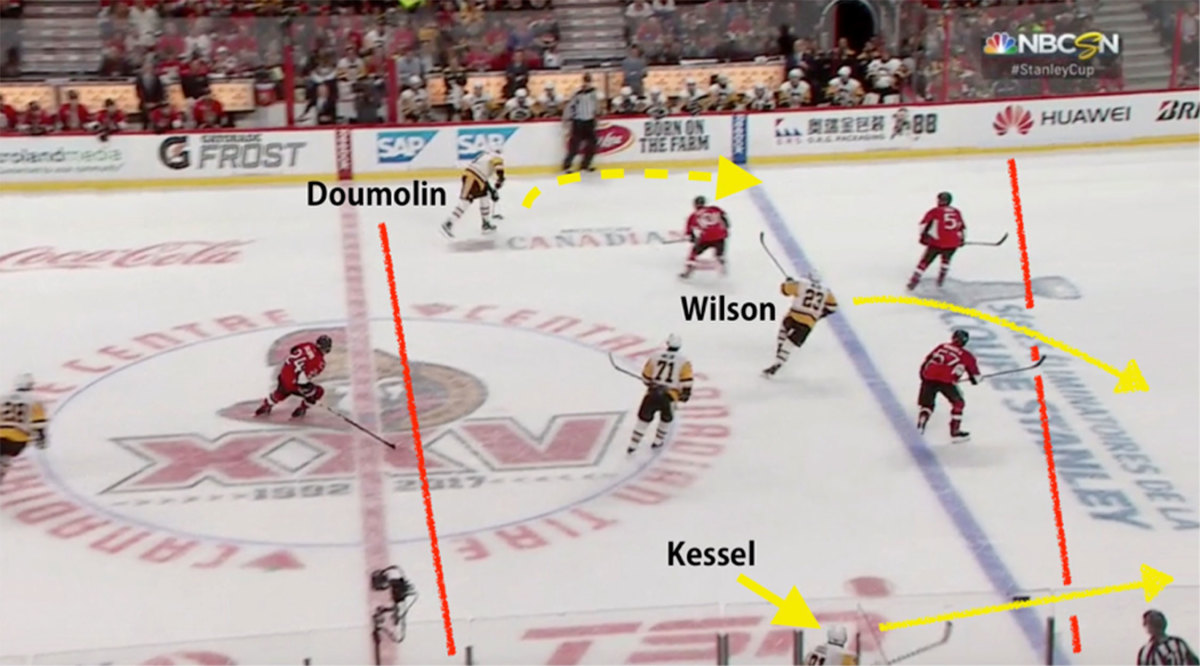
Even though Phaneuf wins the puck, he doesn't have the time and space to make a decision like he did on that sequence from Game 1. Instead, Kessel is on his hip and Wilson is below the faceoff dot, reading Phaneuf's movement. If he tries to reverse the puck, Wilson can attack the puck carrier down low, or Doumolin can meet the puck if it's rimmed around. If he tries to cut against the grain on Kessel, he can continue toward the puck.
Kessel and Wilson force Phaneuf into a turnover and seconds later, Doumolin scores off a point shot.
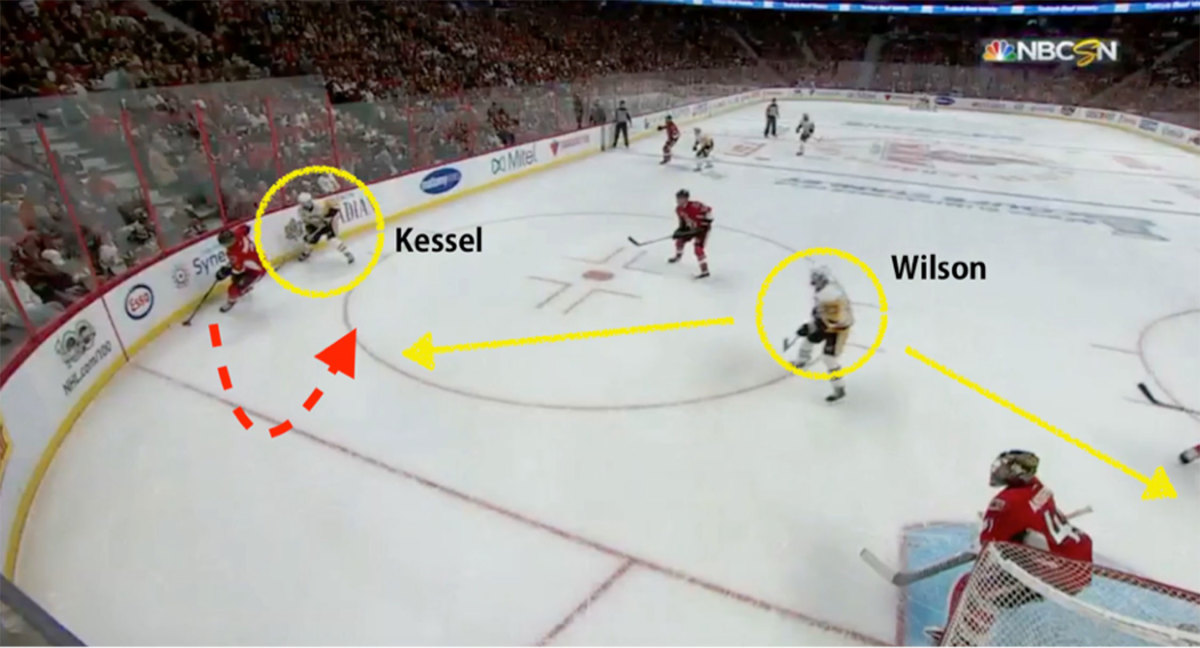
Right before Matt Cullen made it 5-0 in Game 5, the Penguins used their forecheck to create another turnover, beginning an extended shift in the offensive zone that ended with Cullien scoring.
Bryan Rust is breaking out the puck for Pittsburgh, with Viktor Stalberg the high forechecker for Ottawa funneling him up the wall.
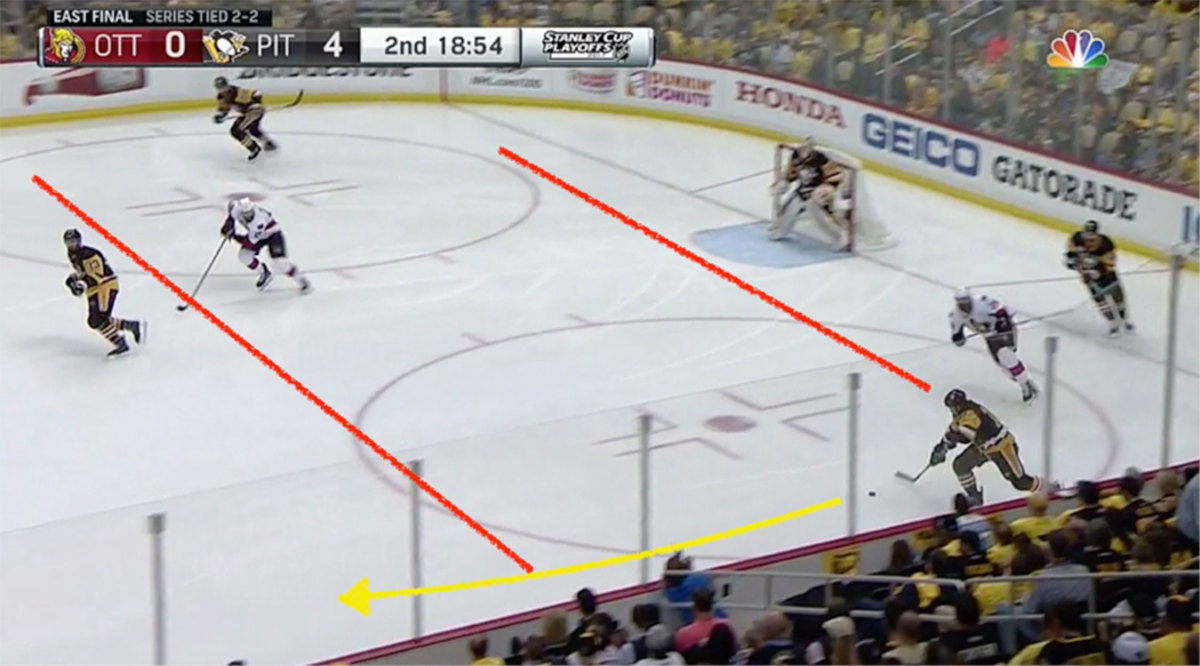
But when Rust gains the red line, instead of flipping the puck deep, he makes an intermediary pass, with Carter Rowney providing puck support up the wall. This does two things: It helps to facilitate a more controlled entry for Pittsburgh, and also makes Chris Wideman check Rowney along the blue line.
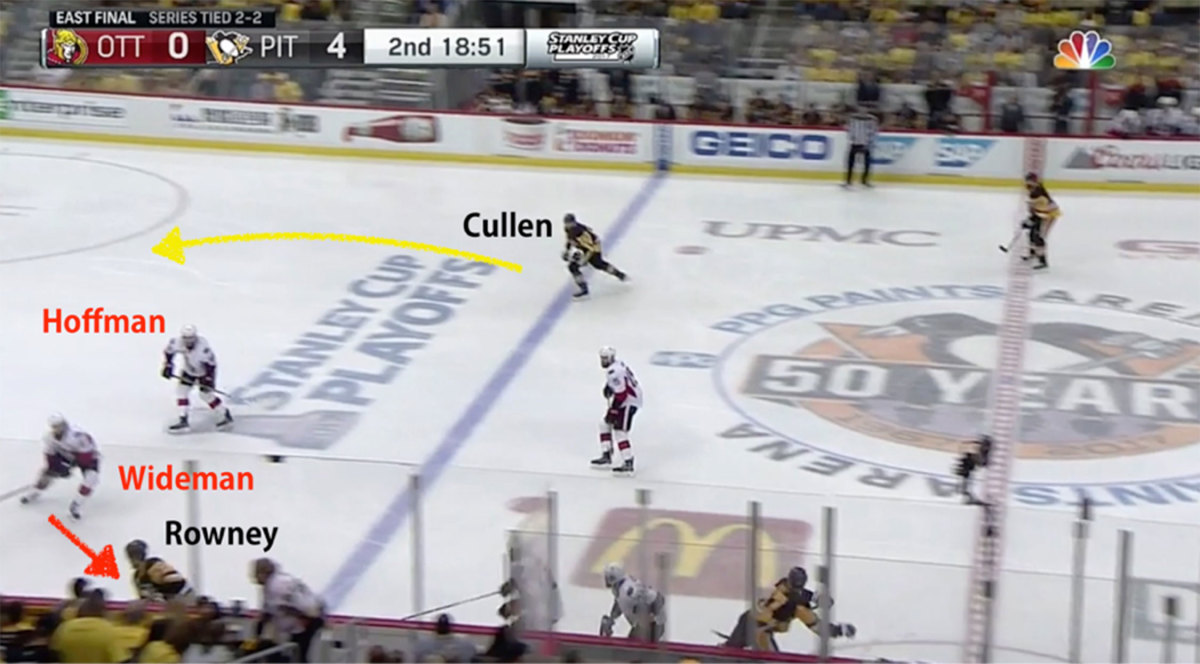
After Rowney dumps the puck deep, Cullen gets in on the forecheck with Mike Hoffman going back on the play. Again, the Penguins are in great position to win possession back. When Hoffman picks his head up, he sees two Penguins along the wall, not the safest area to play the puck. If he tries to reverse it, Cullen could intercept a soft pass, or a clearing attempt might be met by the weak-side Penguins defenseman.
God bless Erik Karlsson: The Senators think their defenseman is Heaven-sent
In the end, the pressure Cullen applies forces Hoffman into coughing up the puck, and Cullen himself scores off the ensuing Pittsburgh possession.
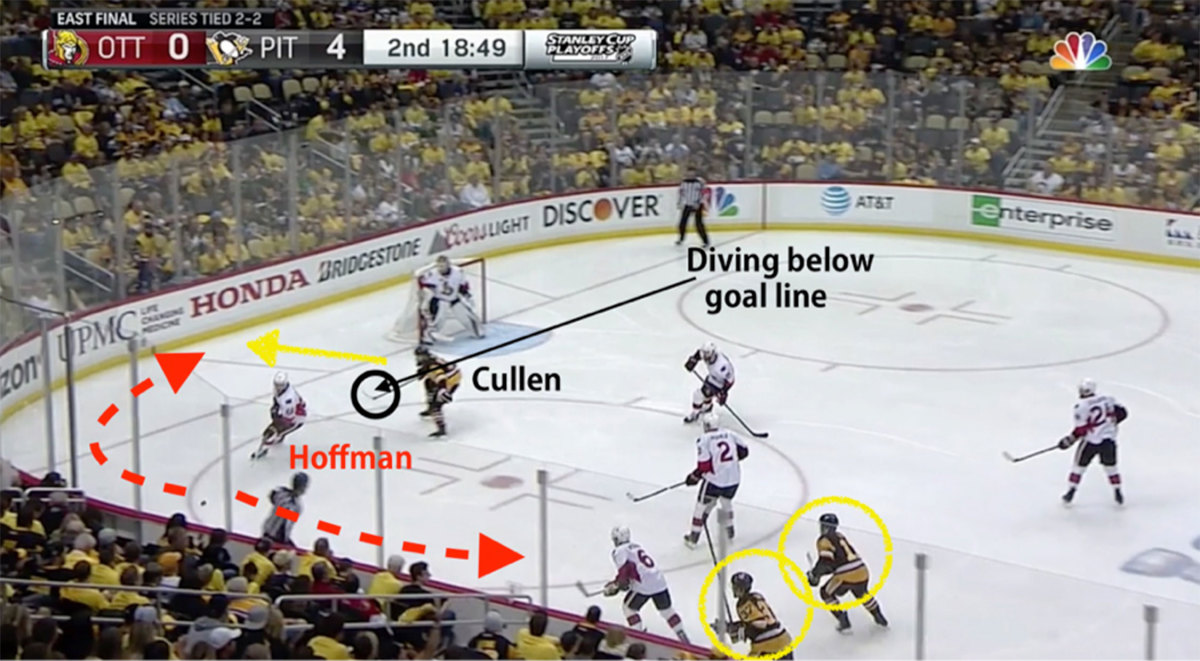
By changing the layout of their forecheck, Pittsburgh has flipped the script, pressuring Ottawa into defensive zone turnovers. It's been a calculated tactical adjustment by the Penguins, who have attacked the Senators at the right moments to create offensive opportunities.
Of those five goals created by the Penguins forecheck, one came against Erik Karsslon (Wilson's Game 5 goal, which, if Karlsson made a bad play to begin, his mistake was compounded by a much worse play). But what this shows is the Penguins are picking their spots against Ottawa; Karlsso wasn't on the ice for any of the other four goals.
If the Penguins can continue to create offense off its forecheck like this in Game 6, they'll put themselves in a good position to go back to the Stanley Cup Final and defend their 2016 championship.
